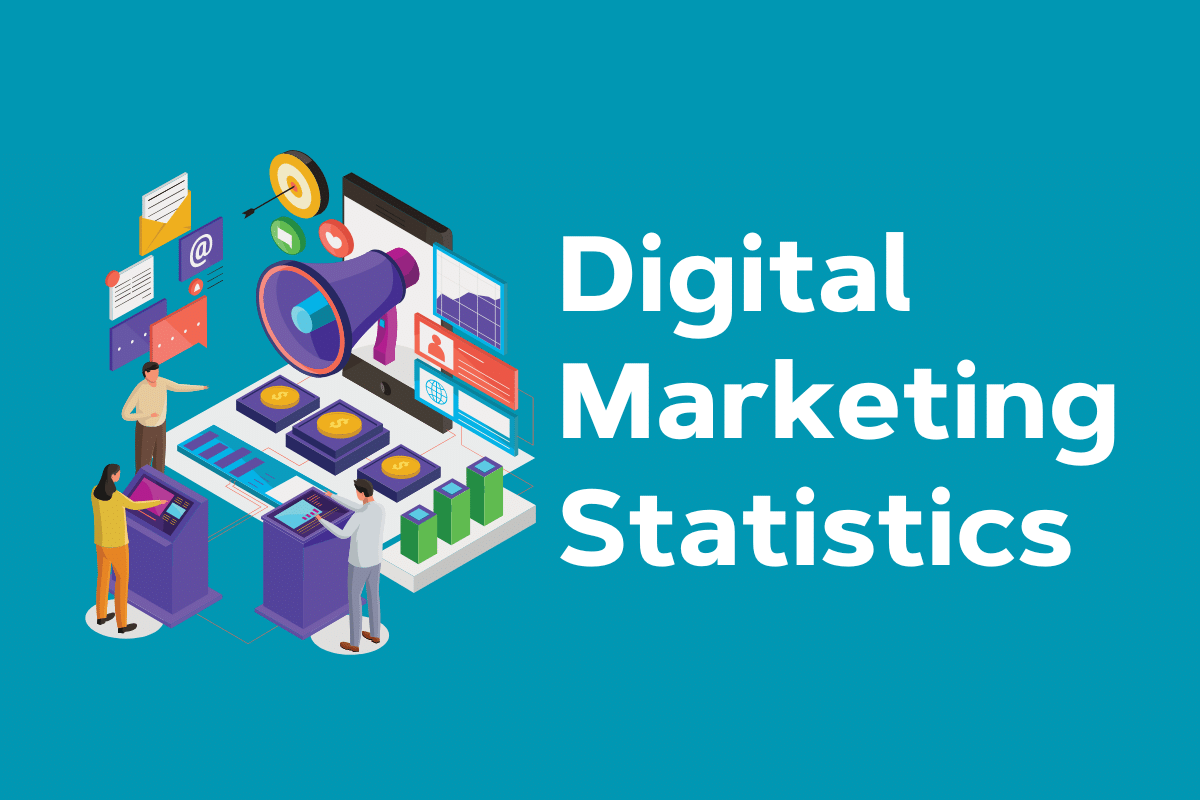Digital Marketing Statistics (How Many Businesses Use Digital Marketing?)
Welcome to our extensive digital marketing statistics roundup!
You must be familiar with the latest trends and facts in today’s growing digital world.
To be successful online, you must adopt new strategies, optimize and improve, regardless of the channel(s) you opt for.
From social and email marketing to SEO, video and influencer, this article dives deep into the world of digital marketing for your convenience. Plus, we also added a section on the importance of martech.
Whether you’re a seasoned marketer or just starting out, this statistical roundup is your go-to resource for staying ahead of the curve and maximizing your online presence.
Go. GO. GOO!
This post covers:
- How Many Businesses Use Digital Marketing?
- Digital Marketing Market Share
- Online Advertising Statistics
- Social Media Marketing Statistics
- Email Marketing Statistics
- SEO Statistics
- Video Marketing Statistics
- Influencer Marketing Statistics
- Marketing Technology/Martech Statistics
Digital Marketing Statistics (Our Top Picks)
- Nearly 60% of small businesses use digital marketing
- Global digital marketing and advertising market forecast to hit $1.5 trillion by 2030
- Digital marketing’s largest segment is search advertising
- Marketers who plan their marketing are 331% more successful than those who don’t
- The cost of ad fraud could reach $100 billion in 2023
- 45% of marketers send emails weekly
- You can increase your CTR by 32% by moving up one position in Google
- Over 90% of businesses use video as a marketing tool
- The influencer marketing market hit $16.4 billion in 2022
- Nearly 90% of companies plan to use marketing automation
You may also be interested in reviewing our most important advertising statistics collection.
How Many Businesses Use Digital Marketing?
Unfortunately, there’s no exact stat on how many businesses globally use digital marketing, but we still found a few worthy mentions.
1. Nearly 60% of small businesses use digital marketing
First, almost 90% of small businesses use some type of advertising, whether traditional or digital, or a mixture of both.
Moreover, 58% of small businesses use digital marketing, and nearly all plan to invest more of their marketing budgets into it. Additionally, 63% are spending the most on social media.
Fun fact, the six most common digital marketing channels small businesses invest in are 1) social media (73%), 2) website (73%), 3) email marketing (57%), 4) SEO (49%), 5) video (34%) and 6) content marketing (32%).
Source: Workswit IT Solutions
2. 72% of the UK’s marketing experts direct their budgets toward online marketing
More than two-thirds of the UK’s marketing experts are directing their budgets (most of it) toward online marketing.
It’s also said that one-quarter of UK businesses’ overall marketing budget will be reserved for social by 2026.
Source: Statista #1
3. 56% of marketing funds are oriented to digital channels
In the annual CMO marketing spending research, Gartner reported that 56% of the budget is allocated to digital channels and 44% to offline channels. Furthermore, more than 50% of the digital spending is invested in paid channels (social, search, display and video).
The businesses’ marketing budgets also increased from 6.4% in 2021 to 9.5% in 2022 as a percent of the company revenue.
Source: Gartner
4. Nearly 70% of startups use marketing tools, but too few use them properly
While 68% of startups use marketing technologies in their organization, only 59% have a strategic plan for using them. Unfortunately, 41% of startups without a plan usually say the tech doesn’t meet their business objectives (which is obvious, don’t you think?).
Source: GetApp
5. There are 428,000+ global advertising agency businesses
While this number relates to all advertising agencies, offline and online, it’s still great knowing that there are more than 428,000 worldwide. In this day and age, it’s safe to say that most of them deal with at least some kind of digital advertising.
Source: IBISWorld
Digital Marketing Market Share
6. Global digital marketing and advertising market forecast to hit $1.5 trillion by 2030
The digital marketing market is continuously rising – growing at a CAGR of 13.9%. So it’s expected to reach a whopping $1.5 trillion by 2030.
As a reference, the digital advertising market is projected to reach $680 billion in 2023.
Source: Digital Advertising and Marketing: Global Strategic Business Report
7. Digital marketing’s largest segment is search advertising
At roughly half of the total ad spending, search advertising has the largest market share with an excepted 2023 volume of $280 billion.
Source: Statista #2
8. Digital marketing market share around the world
Out of all the countries in the world, the most ad spending will be generated in the United States.
China, the United Kingdom, Japan and Germany are the other four highest in revenue – the rest in the table below are randomly selected.
| Country | Digital advertising market |
| United States | $118.2 billion |
| China | $56.1 billion |
| United Kingdom | $21.5 billion |
| Japan | $10.4 billion |
| Germany | $8.1 billion |
| Canada | $7.3 billion |
| Australia | $5.7 billion |
| France | $5.4 billion |
| Brazil | $3.9 billion |
| India | $1.7 billion |
| Ireland | $393 million |
Source: Statista #2
9. 69% of total ad spending will be mobile by 2027
With mobile becoming bigger each passing year, digital marketing is also revolving more around investing in mobile advertising (more than ever before). And by 2027, the total share of all digital marketing revenue will be generated through mobile.
If you’re not testing mobile yet, you should better do it ASAP.
You should also not miss our must-read mobile marketing statistics.
Source: Statista #2
10. Almost 81% of digital advertising revenue will be generated through programmatic advertising by 2027
Artificial intelligence and technology are growing in popularity by the day and are already highly valued by marketers all over the world.
Combine technology and advertising, and you get programmatic advertising, which will account for nearly 81% of total digital advertising revenue by 2027.
Source: Statista #2
Online Advertising Statistics
11. Almost half of the businesses don’t have a defined digital marketing strategy
Even though 45% of businesses are doing digital marketing, they don’t have a defined strategy for it. Moreover, 38% of businesses have it integrated into their marketing strategy and 17% have a defined strategy laid out in a document.
Source: Smart Insights
12. Marketers who plan their marketing are 331% more successful than those who don’t
Those marketers and marketing teams that plan and document their strategies are more than three times likelier to experience success than those that don’t.
However, only 17% of marketers always plan their marketing campaigns ahead of time.
| Do you plan marketing campaigns? | Share of respondents |
| Usually | 46% |
| Sometimes | 28% |
| Always | 17% |
| Rarely | 7% |
| Never | 3% |
Source: CoSchedule
13. 33% of marketers use paid advertising for brand awareness
When growing a business organically, it can take a lot of patience because it can take months, heck, years to see some tangible success. But investing in marketing can reduce the waiting by A LOT.
One-third of marketers report they use paid advertising to increase their brand awareness.
Source: HubSpot #1
14. Customers are 59% likelier to convert through search after seeing a display ad
When potential buyers see a display ad, and they end up doing a search related to it, they are nearly 60% likelier to convert.
Interestingly, the search activity can rise by 155% after customers see a display ad, while 27% of customers are more prone to search for a business.
Source: LocaliQ
15. The cost of ad fraud could reach $100 billion in 2023
A pretty significant increase in ad fraud is expected in 2023, going from $81 billion in 2022 all the way to $100 billion.
This tells us that we should not take digital ad fraud lightly because it costs businesses a lot of money.
Source: Business Of Apps
Social Media Marketing Statistics
I bet you’ll also be excited to learn about how many people use social media through our social media statistics.
16. Social media ad spending is forecast to hit $247 billion by 2030
The 2023 social media ad spending is expected to expand to $207 billion in 2023. However, it’s projected to increase at an annual growth rate of 4.53%, reaching $247 billion by 2030.
It’s also worth mentioning that the most social media ad spending in 2023 will happen in the United States – $72.3 billion.
Source: Statista #3
17. Facebook is the most popular social media platform amongst marketers globally
In a global survey, a whopping 90% of respondents said they used Facebook as a marketing platform to advertise their business. (And nearly 80% used Instagram.)
When it comes to the social media advertising market, Facebook’s market share accounted for 16% in 2022.
Fun fact: Facebook is also the most popular social network worldwide, with nearly 3 billion users.
Source: Statista #4
18. Increased exposure is the main benefit of using social media marketing
When asked professionals which are the main benefits of social media marketing, 85% reported using it to increase exposure. Increased traffic and lead generator are the second and third most common benefits.
| Benefit of social media marketing | Share of respondents |
| Increasing exposure | 85% |
| Increasing traffic | 75% |
| Lead generation | 66% |
| Fan loyalty | 58% |
| Improving sales | 57% |
Besides, lead generation and audience reach are two of the main reasons why marketers decide to advertise on social media platforms.
Source: Statista #4
19. Almost 70% of marketers will increase their video activities on Instagram
68% of worldwide marketers stated they would increase their video activities on Instagram, while one percent less said they would do so on YouTube.
Video marketing is huge, but we will touch on it below.
Have you seen our Instagram engagement rate statistics?
Source: Statista #5
20. Mobile social media advertising spending reached around $141 billion in 2022
This makes social media advertising the largest form of mobile advertising spending, followed by mobile banner ads ($128 billion), search and video advertising.
Source: Statista #6
Email Marketing Statistics
21. Over 64% of small businesses use email marketing
Although social (Facebook in particular, 69.6%) is still the most preferred way of reaching customers, small businesses’ second method is email marketing (64.1%). Surprisingly, direct mail is more common than Instagram (48.3%) and Twitter (47%).
It’s also reported that email marketing is the easiest channel for small businesses.
Source: Campaign Monitor
22. 45% of marketers send emails weekly
Have you ever wondered how often you should send emails to your subscribers? 45% of marketers do it weekly, while over 30% do it several times a week. Less than 10% do it daily.
Moreover, over 40% reported that Tuesdays are the best time to send marketing emails, while marketers don’t prefer Fridays and weekends.
Source: Databox
23. 72% of marketers reduce email frequency to those who are no longer opening messages
When the stats report that subscribers aren’t opening emails or clicking links, 72.1% of marketers reduce their email frequency. Hey, you don’t want to annoy them because you still can win them over if they don’t click the “unsubscribe” button.
However, the other 27.9% of marketers don’t change the frequency, sending the same volume of emails to everyone on their email list. This is a bad practice because a low sender score will mess up your deliverability rate.
Source: Databox
24. A/B testing can increase your ROI by nearly 30%
If you’re not satisfied with the performance of your email marketing campaigns, you MUST test and optimize them.
One of the best and most straightforward approaches is A/B testing (always test one thing at a time), which can increase you’re return by up to 28%. Don’t forget – QA and spam testing is also crucial.
Source: Litmus
25. Marketing emails influence 59% of subscribers’ purchasing decision
Email marketing is powerful. Almost 60% of respondents reported that marketing emails influence their purchasing decisions.
Not just that, but more than half of them buy at least once a month because of marketing emails. In addition to that, 34% make purchases multiple times monthly but only 3% once or more weekly.
Keep in mind, only 1.9% said they never purchased or that marketing emails have no impact on their purchasing decisions.
Source: SaleCycle
26. The industry’s average bounce rate is approximately 10%
When considering all industries, the average email bounce rate is 10.1%. One of the highest bounce rates have industries like legal services (15.7%), manufacturing and distribution (14.9%), real estate (13%) and nonprofit organizations (12.2%).
Source: Constant Contact
SEO Statistics
27. Google’s search engine market share is at 85%+
Google has been leading the search engine market for a long time and is FAR ahead of the competition. Its one of the highest current search engine market shares was in 2018 at over 91% but has slightly dropped in 2023 to 85.5%.
As a reference, Bing’s share is approximately 8.2% and Yahoo!’s is 2.4%
Source: Statista #7
28. You can increase your CTR by 32% by moving up one position
If you jump from fourth to third position in Google, it can mean a whopping increase of 32% in click-through rate. Keep in mind that the CTR depends on the position you’re jumping to.
Yes, jumping to the first position will have a much higher CTR (74% improvement) than jumping to the fifth one (29% improvement). But moving from tenth to ninth position will mean scoring 11% more clicks.
Source: Backlinko
29. Over 90% of content gets 0 Google traffic
Shockingly, 90.6% of content gets absolutely no traffic from Google.
Fun fact: Less than 6% of pages rank in Google’s top ten search results for at least one search query.
| Number of visits | Share of websites that get Google traffic |
| 0 | 90.6% |
| 1-10 | 5.3% |
| 11-100 | 2.9% |
| 101-1,000 | 1% |
| 1,001+ | 0.2% |
Source: Ahrefs
30. 66.3% of websites have no backlinks/referring websites
One of the reasons for receiving no traffic from Google is having no backlinks or referring domains – that’s 66.3% of websites. Wow.
Moreover, only 2.1% of websites have 11-100 referring domains, and even less, 0.08%, 101+ backlinks.
| Number of backlinks | Share of websites |
| 0 | 66.3% |
| 1-3 | 27% |
| 4-10 | 5.2% |
| 11-100 | 2.1% |
| 101+ | 0.08% |
Source: Ahrefs
31. The average cost of buying a link is $361
While the research was small (450 sites), the number is still too general, but the average cost of niche edits/buying links is $361.
Joshua also found that only 12.6% of the sites he contacted were willing to sell him links. 8.8% said no and the rest didn’t even respond.
Everyone who ever reached out to other website owners hoping to buy a link knows what’s up.
Source: Ahrefs
32. The average cost of buying a guest post is $78
You’re wrong if you think sneaking in an article your link is cheaper than publishing a guest post. The latter is way cheaper, costing, on average, $77.8.
Moreover, out of 25.5% of site owners who responded, 12.2% didn’t ask for money and 13.3% did.
Source: Ahrefs
Video Marketing Statistics
33. Over 90% of businesses use video as a marketing tool
Video is getting increasingly popular, thanks to YouTube and other video-sharing platforms. It’s more fun to watch a video than read an article (except if it’s reading this interesting digital marketing statistics).
Thus, in 2023, 91% of businesses will use video as a marketing tool, a 5% jump from 2022 and a 30% jump from 2016.
Source: Wyzowl
34. 70% of those not using marketing videos will start in 2023
While there are many reasons for not using video marketing (lack of time, not knowing where to start, too expensive, etc.), 70% of those not using this channel will begin in 2023.
Luckily, creating videos is a lot easier, faster and cheaper today than it was just a few years ago.
Source: Wyzowl
35. Live action videos are the most popular style of videos
In 2022, the most common style of marketing video was a live action video, followed by screen recorded video and animated video. Still, there’s no huge deviation from the three, as you can see from the table below.
| Style of video | Share of respondents |
| Live action | 66% |
| Screen recorded | 57% |
| Animated | 55% |
Source: Wyzowl
36. 71% of marketers create social media videos
Everyone’s on social media, and everyone’s binging on videos (usually hours per day), so it’s no secret that 71% of marketers created social media videos in 2022.
Other popular types were explainer videos (70%), presentation videos (50%), testimonial videos (46%), video ads (46%) and teaser videos (42%), to name a few.
Source: Wyzowl
37. Only 4% spend $20,000 on marketing videos
A very tiny percentage (4%) of marketers spend tens of thousands of dollars on creating (the ultimate) marketing videos for their campaigns. The largest share of marketers spend anywhere between $0 and $500 per video.
| Spend on video | Share of respondents |
| $0 – $500 | 42% |
| $501 – $1,000 | 18% |
| $1,001 – $5,000 | 25% |
| $5,001 – $10,000 | 9% |
| $10,001 – $20,000 | 3% |
| $20,000+ | 4% |
Source: Wyzowl
Influencer Marketing Statistics
38. The influencer marketing market hit $16.4 billion in 2022
The influencer marketing market has been growing rapidly for the past years, growing from $1.7 billion in 2016 to $16.4 billion in 2022. For 2023, it’s forecast to jump all the way to over $21 billion.
| Year | Market size |
| 2023 | $21.1 billion |
| 2022 | $16.4 billion |
| 2021 | $13.8 billion |
| 2020 | $9.7 billion |
| 2019 | $6.5 billion |
| 2018 | $4.6 billion |
| 2017 | $3 billion |
| 2016 | $1.7 billion |
Source: Statista #8
39. Almost 90% of marketers name Instagram as the most important platform for influencer marketing
A survey from 2020 found that 89% of marketers chose Instagram as the most crucial platform for influencer marketing, followed by YouTube in second place (70%). Other popular platforms are Facebook, Twitter and LinkedIn.
Source: Statista #9
40. 33% of Gen Zers made a purchase based on influencers’ recommendations
A HubSpot survey found that around one-third of Gen Zers made a purchase based on influencers’ recommendations in the past three months (when the survey was sent out).
Interestingly, Gen Zers report that influencers have a much more significant impact on their purchasing decisions than recommendations from their family and friends.
Source: HubSpot #2
41. 1 in 4 marketers benefit from influencer marketing
While one in four marketers currently leverage the power of influencer marketing, the rate will likely increase because of the excellent return on investment (9%).
It’s said that nearly 20% of marketers will invest in this type of marketing for the first time in 2023. In addition, 89% of marketers already using influencer marketing plan to invest even more into it.
Source: HubSpot #2
42. Micro-influencers have a higher engagement rate (60%) than macro-influencers
The size of the influencers’ following may not be that important. After all, micro-influencers have a much better engagement rate (up to 60%) than macro-influencers.
The engagement rate is the best for influencers with low thousands of followers but starts to plateau at approximately 100,000 followers.
Fun fact: 50% of millennials trust the influencers they follow, while less than 40% trust their favorite celebrities.
Source: Emplifi, Morning Concult
Marketing Technology/Martech Statistics
43. Around 62% of marketers use built-in marketing or CRM software for reporting
Marketing reporting (and organization) is key to reap the benefits of it. Approximately 62% of marketers reported using built-in marketing or CRM software for reporting (statistics).
Source: HubSpot #1
44. The global marketing technology market hit $344+ billion in 2021
With the rise of digital marketing came the need for marketing technology solutions. After analyzing the data of the global martech market, the report revealed its enormous size, valued at $344.8 billion.
The United States and the United Kingdom have the largest shares both valued at nearly $150 billion in 2021.
Source: Statista #10
45. There are almost 10,000 marketing technology solutions worldwide
At a market size of that size, it’s expected that there will be many tools and software available, but 10K?
In 2022, there were a whopping 9.932 martech solutions available worldwide to marketers and professionals.
As a reference, there were only 150 such solutions in 2011.
Source: Statista #11
46. Nearly 90% of companies plan to use marketing automation
Shortly, 87% of companies plan to invest in marketing automation, while only 2% say they don’t plan to use it.
Remember, More than 70% of successful companies use automation because it benefits them in many ways regarding growth.
We also have a comprehensive list of the most essential marketing automation statistics you should know about.
Source: ResearchGate
47. 100% of teams where marketing and sales work together use Martech
You rarely see 100% mentioned in any statistical roundup, but we’re doing it (for the first time).
All the professional teams where marketing and sales work in unison to close prospects use marketing technology (like automation, sales enablement tools, etc.).
It’s Martech that keeps top players ahead of the game, so if you’re not using the technology, you should consider it.
Source: American Marketing Association
Conclusion
In conclusion, digital marketing is an ongoing, ever-evolving field that continues to shape how businesses connect with their target audiences.
If you aren’t leveraging the power of digital platforms, tools and software, those that do will surpass you (easily).
Throughout this article, we have explored a range of insightful statistics that highlight the current trends and strategies in digital marketing.
Remember, digital marketing is a dynamic field, so continue exploring, experimenting and refining your strategies to achieve your goals and connect with your target audience.








This Post Has 0 Comments